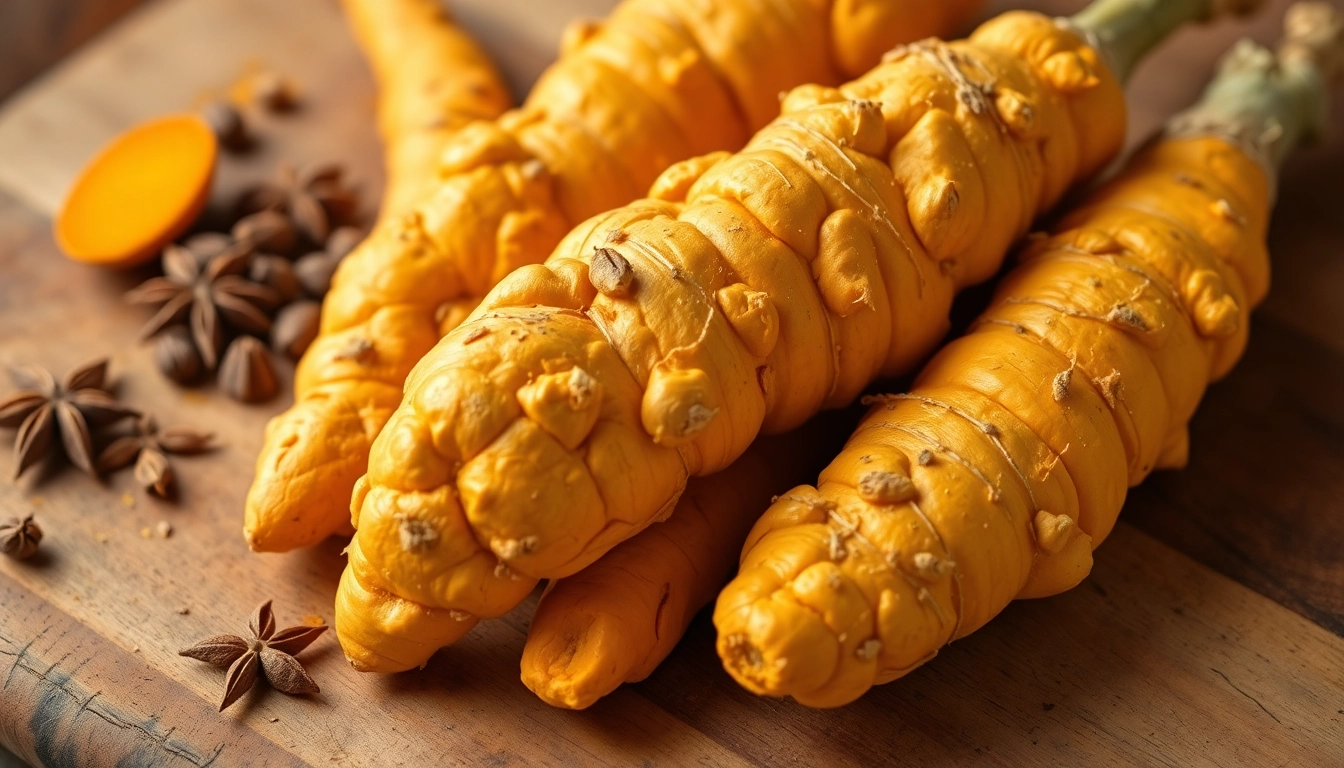
What is Turmeric Root?
Turmeric root, scientifically known as Curcuma longa, is a flowering plant belonging to the ginger family, Zingiberaceae. It is primarily cultivated for its rhizome, which is the underground stem that is commonly referred to as turmeric root. This vibrant orange-colored root has been an integral part of culinary and medicinal traditions in various cultures, particularly in Asia. Rich in nutritional properties, turmeric root is renowned for its unique flavor, vibrant color, and potential health benefits, making it a staple ingredient in many kitchens around the world.
Understanding Its Botanical Background
Turmeric is native to Southeast Asia and requires a warm climate to thrive. The plant grows up to 3 feet tall and produces beautiful yellow flowers. When harvested, the rhizomes are typically boiled, dried, and ground into a fine powder for culinary and medicinal use. The chemical composition of turmeric root includes the active compound curcumin, which is attributed to many of its health benefits and is often studied for its anti-inflammatory and antioxidant properties.
The Culinary Uses of Turmeric Root
In the culinary world, turmeric root is prized not only for its flavor but also for its vibrant yellow color, which enhances dishes aesthetically. It is a common ingredient in numerous cuisines, especially Indian, where it is a critical component of curry powders. Turmeric root can be used fresh, dried, or in powdered form, imparting a warm, earthy flavor to meals ranging from soups and stews to rice and meat dishes. For those wanting to experiment, the following methods show how this versatile ingredient can be integrated into cooking:
- Fresh Turmeric: Grated or sliced and added to stir-fries, smoothies, or vegetable marinades.
- Dried Powder: Used in curry blends, sauces, soups, or as a coloring agent in rice dishes.
- Turmeric Tea: Brewed with hot water, fresh ginger, and a pinch of black pepper for enhanced absorption of curcumin.
Traditional Medicine and Cultural Significance
Historically, turmeric has been revered not only for its culinary uses but also for its medicinal properties. In Ayurveda, traditional Indian medicine, turmeric root has been utilized for centuries to treat a variety of ailments, including digestive issues, skin diseases, and respiratory conditions. Its cultural significance extends to various rituals and ceremonies where it symbolizes purity and auspiciousness. This long-standing heritage underlines the acceptance of turmeric root as a natural remedy and contributes to its popularity in modern wellness practices.
Health Benefits of Turmeric Root
Recent scientific research has validated many of the traditional claims associated with turmeric root, particularly those relating to its health benefits. Here, we explore some of the compelling reasons to incorporate turmeric into your diet.
Anti-Inflammatory Properties
One of the most significant health benefits of turmeric root is its powerful anti-inflammatory effects. Curcumin, the active component of turmeric, has been shown to inhibit inflammatory pathways and molecules in the body. This is particularly beneficial for individuals suffering from chronic inflammatory conditions such as arthritis, where curcumin can potentially mitigate pain and improve joint function.
Antioxidant Effects and Nutrition
Another notable advantage of turmeric root is its high antioxidant capacity. Curcumin is recognized for its ability to combat oxidative stress and free radicals in the body, ultimately reducing the risk of chronic diseases and promoting overall health. Incorporating turmeric into your diet can help enhance nutritional intake; the root is rich in various essential vitamins and minerals, including vitamin C, vitamin B6, iron, and manganese. Moreover, it contains dietary fiber, which supports digestive health.
Potential Benefits in Chronic Conditions
Extensive research has indicated that turmeric root may offer health benefits in managing chronic conditions such as heart disease, diabetes, and certain cancers. Studies suggest that curcumin may lower blood sugar levels, improve insulin sensitivity, and reduce the risk of heart disease by improving endothelial function. Moreover, its anticancer properties are being investigated for possible impacts on tumor growth and cancer progression. While more research is needed, the preliminary findings are promising, highlighting turmeric root as a powerful ally in the prevention and management of various health conditions.
How to Incorporate Turmeric Root into Your Diet
Incorporating turmeric root into your meals can be both simple and enjoyable. Here are some methods to ensure you get the most out of this golden spice:
Fresh Turmeric Root: Cooking Techniques
Fresh turmeric root can be used in various cooking techniques to enhance flavor and nutritional value. Here are some common approaches:
- Teas and Beverages: Grate fresh turmeric and steep it in hot water, adding honey, lemon, or ginger for added flavor and benefits.
- Smoothies: Blend fresh turmeric root with fruits and greens for a nutritious drink packed with antioxidants.
- Cooking: Incorporate sliced or grated turmeric into curries, soups, and vegetable stir-fries for a healthful boost.
Recipes Featuring Turmeric Root
Creating delicious recipes with turmeric root can make healthy eating enjoyable. Here are a few ideas:
- Turmeric Cauliflower Rice: Sauté riced cauliflower with fresh turmeric, garlic, and onions for a colorful side dish.
- Curried Lentil Soup: Combine lentils, diced vegetables, and a turmeric-infused broth for a hearty meal.
- Golden Milk: Warm milk (or a dairy-free alternative) with grated turmeric, cinnamon, ginger, and a sweetener for a soothing drink.
Supplement Options: Powders and Extracts
For those who may find it challenging to incorporate enough turmeric root into their diets, dietary supplements in the form of powders, capsules, and extracts are widely available. When choosing a supplement, it is essential to look for high-quality products containing curcumin or turmeric extract, preferably standardized for curcumin content, to ensure maximum benefit. Additionally, supplements combined with black pepper extract (piperine) may enhance curcumin absorption in the body.
Precautions When Using Turmeric Root
While turmeric root is generally safe for most people and can provide many health benefits, there are important precautions to consider before adding it to your routine.
Possible Side Effects and Interactions
Although turmeric root is often deemed safe, excessive consumption can lead to side effects such as gastrointestinal issues, nausea, or increased risk of bleeding. People taking blood-thinning medications or those with certain medical conditions should consult with a healthcare professional before incorporating significant amounts of turmeric into their diet. Additionally, individuals with gallbladder issues should use turmeric cautiously since it can stimulate bile production.
Recommended Dosage and Consumption Guidelines
For culinary use, moderate amounts of turmeric are typically safe. The general recommendation for turmeric supplementation varies, with dosages ranging from 500 mg to 2000 mg of curcumin per day, but it’s essential to follow the instructions provided on the product label or consult a healthcare provider for personalized advice.
Consulting with Healthcare Professionals
Before starting any new dietary regimen, particularly one involving substantial amounts of turmeric or supplements, it is wise to consult with a healthcare professional. This is particularly crucial for those with pre-existing conditions, pregnant or breastfeeding individuals, or those on medication. A healthcare provider can help ensure that turmeric will be safe and appropriate for your specific health needs.
Where to Buy Quality Turmeric Root
Finding quality turmeric root involves knowing where to look, whether you prefer shopping locally or online.
Farmers Markets and Local Stores
Visiting farmers markets and local grocery stores is an excellent way to purchase fresh turmeric root. Here, you have the opportunity to ask about the freshness and source of the product. Organic markets may also offer high-quality options that prioritize sustainable farming practices.
Online Retailers for Fresh and Dried Turmeric
There are numerous online retailers providing different forms of turmeric root, including fresh, dried, and powdered. Consider well-reviewed brands known for their commitment to sourcing quality ingredients. An example to consider is Turmeric Root available at specialty stores that prioritize organic products.
Identifying Authentic Organic Sources
When purchasing turmeric, look for certified organic options, as these are less likely to contain harmful pesticides and additives. Examine product labels for sourcing information and certifications such as USDA Organic, which ensure the product meets strict agricultural guidelines. Understanding the origin of the turmeric can also give insight into its quality and potency.







